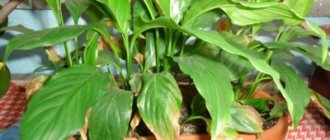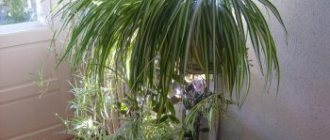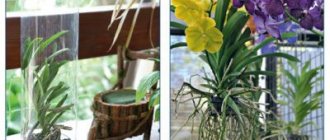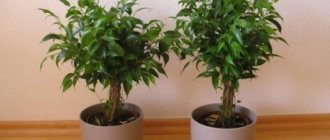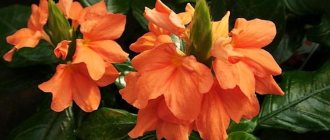The herbaceous perennial chlorophytum is very popular among lovers of indoor plants: it is not too demanding to care for, is compact and elegant, and is often used in flower arrangements and as an hanging plant. However, in order for the bush to always look attractive and neat, caring owners must closely monitor its appearance and promptly notice features that may indicate that the plant is suffering and is in danger.
Leaves become limp and pale
The plant requires bright, diffused light. The variegated varieties of chrophytum are especially demanding for this, while the green-leaved varieties easily tolerate slight partial shade. In low light conditions, chlorophytum quickly withers, and the color of its foliage becomes less saturated and faded.
Plants also suffer in conditions of overheating and insufficient soil moisture. In a room environment, especially in the spring-summer period, chlorophytum must be watered quite often and abundantly, and also pamper the plant with nutritional supplements at least once every 10 days, alternately using organic compounds and mineral fertilizers for these purposes, otherwise the plant will quickly wilt and become sickly, weakened appearance.
To keep the plant in good shape and look fresh, do not allow dry, stagnant air in the room, regularly ventilate the room, but at the same time protect the flower from drafts and extremely cold temperatures for it - below 10 ° C.
Pests of chlorophytum
Insects that infect chlorophytum can be noticed by carefully examining the above-ground part. Based on external signs, you can easily determine the type of pest and determine what means to combat it.
Reference! It is necessary to get rid of harmful insects in the early stages, before they proliferate too much. With a strong population growth, they are capable of completely destroying the plant.
The type of pest can be determined by the following characteristics:
- a grayish coating that looks like small pieces of cotton wool—mealybug;
- yellow stripes and dry spots - thrips;
- twisted, deformed leaves, on the back of which you can see small insects - aphids;
- the leaves are covered with dark spots, sticky to the touch - scale insects.
What to do when you appear?
First of all, it is necessary to isolate the infected flower from other plants. This will help prevent pests from spreading to neighboring flowers. The place where the chlorophytum stood is thoroughly treated with a soap solution. The above-ground part of the plant is also washed, mechanically removing pests. Then chlorophytum must be treated with insecticides.
When infested with mealybugs, use:
- Aktara;
- Calypso;
- Biotlin.
Thrips are destroyed with Actarofin. When chlorophytum is affected by aphids, treatment with Actellik helps. You can also spray the plant with a water infusion of tobacco leaves or garlic. Actellik will also help against scale insects. Rubbing the leaves with kerosene also works well.
Reference! When treated with insecticides, only adult individuals die. Therefore, it must be carried out 2-3 times with an interval of 14 days. This allows the young animals to be destroyed.
Leaves become covered with brown spots
The leaves of chlorophytum begin to become covered with brown spots if the plant suffers due to regular excessive watering, and, as a result, prolonged stagnation of moisture in the soil. This usually happens in winter, when watering, according to the rules, should be reduced, but due to the high dryness of the air in the room, heated by radiators and radiators, the owners, fearing a lack of fluid in the plant, tend to water it more often and more intensively than necessary.
Due to an excess of moisture in the root space, the tuberous root system of chlorophytum begins to rot. If you do not fundamentally change the approach to caring for the plant, it may die in a very short time. To avoid this, you should make it a rule to additionally water the plant only when the earthen ball has dried out by ¼ of the total volume of the flower pot.
Brief characteristics of the plant
Among the varieties of chlorophytum that are used for decorative growing at home are plants with white-green, green or creamy-green leaves. The developed bunched root system ensures the accumulation of moisture during watering; chlorophytum shoots can be placed in water or transplanted into moist soil for further cultivation. The plant demonstrates good survival rate and stable growth.
The plant was originally brought from Africa, where chlorophytum grew directly on tree bark. The plant was brought to the European continent in the 19th century. Chlorophytum was used to decorate rooms thanks to its neatly falling leaves, the length of which can reach 80 cm, depending on growth conditions. The average diameter is about 50 cm, and the lifespan is more than 10 years.
Among the most common are three main types of chlorophytum. Crested has light green leaves and a shorter stem. Cape is a plant with light green leaves of a unique narrow-lanceolate shape and an unusual keeled end, which gradually taper closer to the base, as well as thick tuberous roots. The winged one differs from the other subspecies of the plant in its lanceolate leaves of a dark green color and a wide oval shape, which gradually taper closer to the base. There are also subspecies “Fire Flash” and “Green Orange”, the main feature of which is orange petioles and a much wider leaf shape.
The rosette of leaves begins to rot
The rosette of leaves of a chlorophytum bush may begin to rot due to waterlogging of the soil or due to the fact that the substrate is too heavy and does not suit the composition of the plant. The ideal soil mixture ratio for chlophytum consists of sand, turf, humus and leaf organic matter in a ratio of 1:2:2:2.
How to create ideal living conditions
Despite the sufficient unpretentiousness and vitality of chlorophytum, providing an optimal environment for the home has a beneficial effect on the appearance and immunity of the plant. The culture is thermophilic and develops well with sufficient lighting without direct sunlight. An indoor flower needs systematic watering and moistening of the green mass.
Sudden changes in day and night temperatures and drafts should not be allowed. Regular ventilation of the room is recommended. If chlorophytum does not grow, there may be a lack of nutritional components, the flower pot is too small or large for the rhizome. It is important to consider the time of year and growing season. Thanks to proper care, you can not only achieve preservation of the color of the leaf blades, but also flowering, which is rare for indoor conditions.
When cultivated in an unfavorable environment, the leaves lose the color characteristic of the variety, become stained, rot or dry out at the ends. In most cases, damaged leaf blades will not recover, but eliminating the influence of unfavorable factors and proper care will lead to the chlorophytum growing new green mass.
Chlorophytum is the most common flower among gardeners because it is easy to care for, does not require special conditions and grows quickly. Also, the plant not only attracts with its aesthetic appearance, but also perfectly purifies the air. But quite often it happens that the tips of the leaves of chlorophytum dry out. What to do in this case?
Portrait
The leaves of Chlorophytum are long, arched, and can be solid green or with longitudinal stripes. Currently, varieties with wider, lanceolate-shaped leaves are becoming fashionable. Chlorophytum is a beautiful and “cheerful” plant that fits well into any interior.
Most often, chlorophytum is grown as an ampel plant, hanging it on the wall or installing it on special stands or “slides”. However, you can place it on a table or on a windowsill, where the flower looks very good.
Chlorophytum comes from the tropics and subtropics of America and South Africa, where it grows in the humid surroundings of rivers and streams. This plant is highly adaptable to home conditions, but when caring for it, you should also remember its native natural conditions.
Leaf tips dry out due to improper watering
Leaves will dry out if watered too much. Excessive watering provokes acidification of the soil, which leads to rotting of the roots. If you continue this process, the flower will die.
The appearance of brown spots along the edges of leaves is called necrosis. With this disease, tissue partially dies. This phenomenon occurs because some of the roots die. For this reason, the flower ceases to receive the substances required for development.
Dry spots on the edge, which appeared due to rotting of the rhizome, are much darker than those spots that are associated with insufficient watering and low air humidity. In the latter case, these will be bright yellow or light stripes.
Excessive watering as a cause of drying out
Necrosis from the edges of the leaves is associated with improper watering. The soil in the pot does not have time to dry out, air does not reach the roots, which is why putrefactive microorganisms begin to multiply. This condition is aggravated by cool air temperatures, as well as the location of the pot in a cold place.
During the warm summer season, many species require abundant watering. However, when it gets cold in autumn and winter, flowers need to be watered less frequently to prevent rotting of the roots and, as a result, drying out.
It can also be a problem if you fertilize too much. Most flowers stop actively growing in autumn and winter, so they need much less additional feeding.
Note! If you continue to fertilize, the soil will become sour and salty, which will greatly damage the roots. In a situation where a flower needs to be watered all year round, it is worth creating warm conditions to prevent the earth from cooling and the presence of drafts
Reproduction methods
Reproduction method
Propagating chlorophytum is not a problem. Most varieties have excellent dividing ability. Various methods are suitable for these purposes. "Green Lily" reproduces:
- seeds;
- dividing the bush;
- leaf rosette.
In practice, it is preferable to grow your favorite variety by dividing the bush or using “children”, since the seed method is longer and more labor-intensive.
Sowing seeds
Planting seeds
Seeds are sown in March. The algorithm of actions is as follows:
- Seeds are soaked in water for a day
- Prepare a mixture of sand and peat (1:1) in advance, which fills the container for planting
- The seed material is laid out on the surface, lightly pressing it against the ground.
- The container is covered with film or glass, creating a mini-greenhouse
- Germination is carried out in a warm, moderately shaded place
- The greenhouse is regularly ventilated and the soil moistened
- Seedlings appear in a month, % germination depends on the quality of the seeds
- Picking is carried out in the phase of 2-3 true leaves
After flowering, a green seed box is formed on the aerial shoot. Then it becomes transparent, and the seeds become black and mature. They are used for sowing.
Dividing the bush
Dividing a bush is an easy way to save money and even if you want to make money on your plants
It is convenient to propagate chlorophytum using this method during the transplantation period. Use an adult plant aged 4-5 years. Step-by-step instruction:
- Before transplanting, water the bush abundantly
- Remove them from the pot and divide them into several parts, being careful not to damage the roots.
- Each “division” must have roots and a leaf rosette
- On small plants, remove damaged roots and dry leaves
- Planted in separate containers
As they grow, they are transplanted into a larger pot every year. This method is applicable for all types of chlorophytums. It makes it possible to quickly obtain an adult plant. A photo of chlorophytums proves that they quickly grow after division.
Young plants propagated by dividing the bush
When dividing an adult bush into several parts, damage to the roots or rosette of leaves is inevitable. This is an excellent environment for the proliferation of microorganisms. The sections will dry better if they are sprinkled with crushed coal.
Leaf rosette
Rooting “babies” and cuttings is the easiest method of propagation
On the hanging shoots after flowering, rosettes of leaves appear, which can be planted for subsequent rooting. They prune from the mother bush, place it in water and wait about a week to root. Then the young bushes are planted in cups. They take root well and quickly gain green mass.
Chlorophytum is easy to propagate by cuttings and layering. In the first case, part of the shoot with a rosette is placed in water and rooted. In the second, the rosette of leaves is not separated from the mother plant with a knife, but is planted in the ground. When the bush grows, prune the chlorophytum, separating it from the mother shoot. New plants should be planted in small pots.
Care rules and additional useful information about the “spider flower” are presented in the video:
CHLOROPHYTUUM care beneficial properties WHY LEAVES TURN YELLOW
Chlorophytum home (120 Photos) - home care, reproduction, transplantation, diseases + Reviews
How to make flower pots with your own hands: outdoor, for home, hanging | Step-by-step schemes (120+ Original Photo Ideas & Videos)
